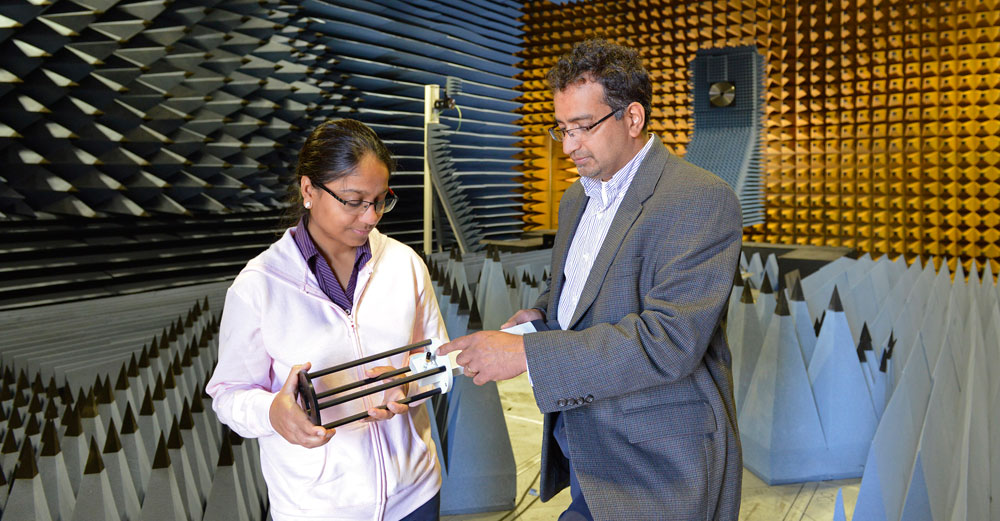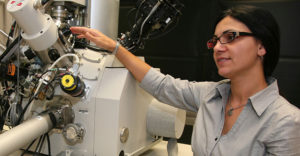
From the toddler glued to “Finding Nemo” on Mom’s phone, to neurologists in different cities sharing brain scan imagery on iPads, people keep crowding the airwaves with more and more data. As this growing demand strains the current infrastructure, network operators are working hard to expand the available capacity.
New technology developed by Patanjali Parimi, director of the Advanced Wireless Systems Research (ADWISR) Center at SUNY Oswego, could soon help wireless networks carry much more data than they do today, moving that information faster and more securely.
Parimi and his team have received a $50,000 investment from SUNY’s Technology Accelerator Fund (TAF) to build and test a prototype device based on a technique called Orbital Angular Momentum (OAM). The ultimate goal is a commercial product, a device that operators can install on network equipment to make data move as much as four times faster.
Commercial wireless companies—the Verizon and AT&Ts of the world—plan to upgrade their networks in the next few years from the current fourth-generation (4G) technology to 5G. Those new networks will operate on higher frequencies, which support faster data transmission. But there’s only so much spectrum available to license on those higher bands, and that’s sparking fierce competition, Parimi says. “They’re going to spend millions of dollars to buy this spectrum.”
Parimi and his team propose an alternative. “We’re trying to enable higher data rates at lower frequencies,” he says. Rather than having to license new spectrum, operators who install Parimi’s invention will be able to push more data through the channels they use today.
How More Data Can Move Through Our Networks
The new device will achieve this by using OAM to modulate the radio signal. Modulation is the technique that inserts information on a radio wave. AM radio networks use amplitude modulation—varying the height of the radio wave in specific ways that represent pieces of information—to carry audio or data. FM radio uses frequency modulation. “OAM modulation twists the wireless beam around its center, making it a spiral wave front,” Parimi says. “The information-carrying beam looks like spiral pasta.”
Installed on a transmitter in a wireless network, Parimi’s device, called a phase plate, will modulate the signal to carry digital information. A second phase plate, installed on the receiver, will demodulate the signal—extracting data from the radio wave.
“We can induce multiple OAM modulations, thereby creating multiple spirals within the wireless beam at a single frequency,” Parimi says. “Each of these modulations can carry one bit of information. But if you introduce a number of modulations, you can carry any number of bits of data. That’s where you can improve the data rate of the signal.”
Using the OAM technique to increase the data rate is something like building a multistory highway, with one road stacked above another and traffic flowing simultaneously at all levels, Parimi explains. That would be good news for network operators, who face an ongoing explosion of wireless usage (think of all those photos your friends upload from their phones to Facebook and Instagram) and wireless devices (smart appliances, security cameras, driverless cars).
The invention improves security because, once the phase plate modulates a wireless signal at the transmitter, it’s impossible to extract data from that signal without a corresponding phase plate at the receiver. That plate must be specifically designed to work with the first one. Hackers who intercepted the signal between the transmitter and receiver would not be able to extract meaningful data. “It would appear like noise to them,” Parimi says.
Although Parimi is currently developing his device for use on commercial wireless networks, the technology would also work on private and government-owned networks, and it could be deployed for a wide range of applications—military, public safety, medical, automotive and many others. “There’s no limit on where this technology can be used,” he says.
Parimi and SUNY Oswego are negotiating with a company that might want to co-develop a product based on the OAM phase plate. Parimi and his team will use the $50,000 TAF award to build several prototypes and run tests on them, based on this potential investor’s criteria. “We’ll be developing a phase plate with multiple orbital angles of momentum,” Parimi says. “We plan to design three or four modulators and demodulators, transmit the signal between each pair and then collect those signals and process them.”
Those tests could bring Parimi’s invention one step closer to the commercial market, where it could help to feed the world’s voracious appetite for wireless data.



